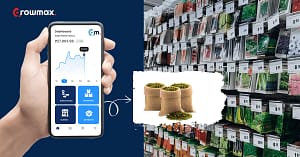The transfer of products from a wholesaler to a retailer or from a retailer to a customer is what distribution management Software is all about. The delivery of commodities to various sorts of entities throughout the supply chain is handled via various distribution channels.
Variations in the degree of customer demand, transportation optimization, and possible outcome for shipment delays are some of the elements that distribution management must examine.
The primary function of DMS is to detect errors and disconnect the problematic component from the system. The DMS “intelligent nodes” may interact with one another regularly, and if a malfunction develops, they can work together to reorganize this.
What is Distribution Management System?
Distribution management is responsible for a company’s whole supply chain, including packaging, inventory, storage, logistics, vendors and suppliers, manufacturers, and retailers. A distribution management strategy is essential for a company’s financial success and long-term existence.
It ensures that everything runs well and the customers are happy. It is critical to a business’s ability to attract customers and maintain a profitable operation.
Its perfect implementation needs the effective management of the whole distribution process.
The larger the organization in size, the more supply points it has. Therefore, the more automation it will need to handle the distribution process effectively.
Significance of Distribution Management System
The marketing philosophy stresses profit generation through client happiness. The distribution function aids in raising the living standards of society’s customers.
Proper distribution of products and services to its customers at the correct time satisfies them and improves their level of comfort.
A Distribution Management System (DMS) will not only help you control your low-level supply chain, but it will also help you control many promotions, boost business productivity, streamline inventory and sales processes, and handle distributor claims – you’ll get accurate and reliable real-time data on secondary sales.
To put it another way, it’s the engine that drives all of your sales and distribution activities, helping you to perform better and be more productive.
Producers and consumers are interlinked through distribution. Producers may use channel members to provide information and notify customers about their products, price, and promotions, among other things.
Elements of a physical distribution system:
Service to customers:
Quality customer service can produce long-term transportation savings, on-time delivery, and more time to focus on other areas of the business. In contrast, poor communication and customer service can hamper relations with customers.
Processing Orders:
As the name implies, order processing ensures that products are in stock before choosing them from inventory and sending them to a sorting area.
Inventory Management:
Inventory management is keeping meticulous records of each new or returning product as it enters or exits a warehouse or point of sale.
Warehousing:
The procedures involved in storing and managing commodities in a designed space are warehousing. Warehousing is the process of coordinating all of the activities, sorting items away, shifting units, handpicking items for assembling, production or shipments, etc.,
Mode of transport:
There are several aspects to consider when deciding on the best form of transportation to get things from point A to point B. This shows efficient transportation which is crucial for the organization’s success.
Handling of Materials:
Business’s profit margins are determined by how rapidly they can turn over their items. The more we can resolve the customer’s issues, the better revenue gets generated, meaning that the company has a better future.
Read anthoer : Inventory Management Software: A Complete Guide for FMCGs
DMS plays a crucial function
Distribution management is the process of monitoring the movement of commodities from a supplier or manufacturer to the point of sale. Activities and operations include packaging, inventory, warehousing, supply chain, and logistics.
Distribution management is an important part of the business cycle for wholesalers and distributors. The speed with which a company can turn through its inventory determines its profit margins.
The more they sell, the more money they make, indicating that the firm has a stronger future. Businesses must have a robust distribution management Software to remain competitive and delight customers.
Functions of the DMS
The following are the primary purposes of distribution channels:
Organizing:
Intermediaries collect items from diverse vendors and divide them into comparable categories based on size, quality, and other factors.
Completion:
Intermediaries keep a significant amount of stock to ensure a constant supply of commodities.
Allocation of resources:
entails sorting the commodities into tiny commercial quantities.
Organizing: Intermediaries get a wide range of commodities from many manufacturers and provide them to consumers in the preferred combinations.
Product Promotion: While the manufacturer carries out most sales promotional activities, intermediaries may also participate in activities such as promotional ads, discounts, etc.
Negotiation: Intermediaries negotiate with the manufacturer and the client simultaneously regarding a product and service, quality, guarantee, and other relevant issues.Influencing factors in the distribution management system
Customer’s Point of View: The ideal situation for every retailer or producer is to have just enough inventory on hand to sell or keep production lines running smoothly. These clients want to have as little inventory on hand as possible without running out.
Distributor’s Point of View: The ideal situation for distribution management is for all fully loaded trucks to be running on regularly planned routes 100% of the time, with a full safety record and a minimum chance of severe weather incidents.
Communication: The customer’s biggest fear is running out of the commodities that they trade in and its associated parts. Effective distribution management ensures the flow of information, forecasting, and accurate, safe, and timely delivery.
Creating a Culture through Planning and Measuring: The first stage is to create a customer-centric mission and corporate culture that balances the significance of customer happiness with the reality of economic success.
Commitment & Training: To teach workers to fulfill the expectations of a distribution business, it involves more than merely explaining and illustrating “how” to execute a task.
Challenges faced in Distribution Management Software
Receive a clear Depictions Of Demand
All corporate resources and activities must be ideally linked with demand, according to distributors. Working with demand estimates or projections is a poor alternative for having a single, full, and up-to-date view of demand.
Control Inventory and costs with visibility
To promote proactive, responsive sales operations, make good purchasing decisions and reduce inventory costs, distributors require real-time inventory data. Distributors cannot measure and enhance company performance without complete visibility.
Execution and coordination with suppliers and customers must be improved
In the distribution sector, success is determined by speed or business velocity. Poorly interconnected systems, reliance on manual procedures, or re-keying data that is already available in one system but not accessible in others is always bad news, causing delays and mistakes.
Growth opportunity with better growth service
Distributors operate in a highly competitive environment. Future orders are influenced by the timeliness of response, the accuracy of information such as lead-time data, and the level of service provided across all contact points for the external client.
Impact of Distribution Management system on FMCG
As previously stated, an FMCG company’s major sales driver is the ease with which its items are available. Through diverse distribution methods, these items reach the firms’ target consumers.
A company neesa a goood distributor management Software to make sure that everything runs properly. DMS uses technology to deliver real-time data about the market’s supply and demand condition to the management.
FMCG firms require an effective distributor and consumer management system to properly estimate consumer demand and cross-check it against distributor inventory on a regular basis.
These firms should explore partnering with India’s leading FMCG distributors to genuinely create a pan-India footprint.
Future of Distribution Management System
New technologies are generating fundamental changes in how distribution works; therefore the economy’s distribution system is never static. On the surface, such adjustments appear to suggest one thing, but when the mechanics are put into action, the outcomes might be surprising.
With unexpected results, producers, distributors, and retailers fight for market share and a larger portion of the overall pie. Some firms try to cover the full market sector, from manufacturing to sale in unique ways.
Some concentrate on becoming an all-purpose middleman while others strive to be the best in a particular field.
Examining whether new technologies are likely to develop in the next few years and how they will affect the distribution system can provide insight into the future of distribution.
Conclusion
As a result, the distribution process benefits the organization in more ways than one. It also helps to keep the business running smoothly.
Everything is running smoothly because of the distribution system. Above all, techniques and functions assist you in comprehending the entire system.
The distribution function’s goal is to manufacture or deliver required commodities to huge groups of clients in
various geographical locations. The aim is to properly store, handle, and preserve items before delivering them to customers in great condition.




